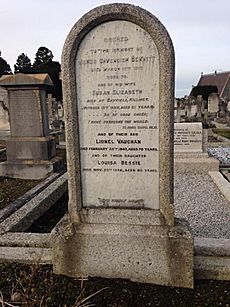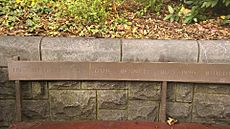Louie Bennett facts for kids
Quick facts for kids
Louie Bennett
|
|
|---|---|
|
Louie Bennett
|
|
|---|---|
| Born |
Louisa Elizabeth Bennett
7 January 1870
|
| Died | 25 November 1956 (aged 86) Dublin, Ireland
|
| Alma mater | Alexandra College |
| Organization | Irish Women's Workers Union, Irish Trades Union Congress, Irish Women's Suffrage Federation |
| Political party | Labour Party |
Louie Bennett (born Louisa Elizabeth Bennett; 1870 – 1956) was an important Irish woman. She fought for women's right to vote, helped workers get fair treatment, and was a writer and journalist.
Louie was born and grew up in Dublin, Ireland. In 1911, she started the Irish Women's Suffrage Federation. This group worked to get women the right to vote. She also helped edit and write for the Irish Citizen newspaper. Louie wrote two books, The Proving of Priscilla (1902) and A Prisoner of His Word (1908). She also wrote for other newspapers.
Louie played a big part in the Irish Women Workers' Union, which helped women workers. She was also the first woman to become president of the Irish Trades Union Congress, a major group for workers' rights in Ireland.
Contents
Louie Bennett's Early Life
Louie Bennett was born on Temple Road in Rathmines, a nice suburb of Dublin. Her family belonged to the Church of Ireland, a Protestant church. She was the oldest of nine children. Her father, James Bennett, ran a family business selling art. Her mother, Susan Boulger, came from a well-known family in Dublin. Later, her family moved to Killiney, a town with views of Dublin Bay.
Louie was first taught at home with her brothers and sisters. Later, she went to a boarding school in England. She also studied at Alexandra College in Dublin. For a short time, she studied music in Bonn, Germany.
When she was young, Louie loved reading novels by famous writers like Charles Dickens and Jane Austen. Reading books by George Eliot made her interested in women's rights. She published two novels: The Proving of Priscilla in 1902 and A Prisoner of His Word in 1908.
Fighting for Women's Vote
What is Suffrage?
People who campaigned for women's right to vote were called suffragettes or suffragists. A "suffragette" was often more active and sometimes used protests. A "suffragist" usually worked through peaceful means.
In the late 1800s, groups fighting for women's vote started appearing in Ireland. Louie Bennett and Helen Chenevix brought many of these groups together. In 1911, they formed the Irish Women's Suffrage Federation (IWSF). This was a main group for peaceful suffrage societies. In 1911, many suffragettes refused to take part in the census (a count of the population) to show they didn't have a voice.
When World War I started in 1914, some suffragists disagreed on what to do. Some British and Irish campaigners stopped their work for the vote. But Louie Bennett believed women should keep fighting for justice, no matter what.
Some members of the Irish suffrage movement also wanted Ireland to be independent from Britain. This caused some disagreements. As one activist, Sidney Czira, explained, suffragists wanted to join the British Parliament, while independence fighters wanted to leave it.
Louie and the Irish Citizen Newspaper
In 1920, Louie Bennett took over the Irish Citizen newspaper. This paper was started in 1912 to support women's right to vote and women's rights in general. It was first edited by James Cousins and Francis Sheehy-Skeffington.
Francis Sheehy Skeffington was sadly killed in 1916. His wife, Hanna Sheehy-Skeffington, then took control of the paper with Louie's help. Louie had actually stopped her subscription to the paper before because she disagreed with some of its views.
In 1916, Hanna Sheehy Skeffington went to America. This left Louie Bennett as a joint editor with Mary Bourke-Dowling. The newspaper was in debt and had shrunk in size. Louie wanted to include more news about trade unions to help sales. In 1920, the Irish Women Workers' Union and the Irish Nurses' Organisation started using the paper as their official journal.
Louie wanted to turn the Irish Citizen into a paper focused on both feminism and workers' rights. However, Hanna Sheehy Skeffington disagreed, and their partnership ended. Hanna's interests also shifted towards the Sinn Féin political party.
Louie was left in charge of the paper until it closed a few months later. It lost funding and support. The printing press was also destroyed by the Black and Tans during the Irish War of Independence. The last issue of the Irish Citizen was published in September 1920.
Helping Workers: Trade Union Work
The Irish Women Workers' Union
The Irish Women Workers' Union (IWWU) was started on September 5, 1911. Its goal was to give women a stronger voice in the workplace. It also aimed to help them win the right to vote and improve their place in society. Constance Markievicz was one of the people who helped start it.
After attending a meeting in 1916, Louie Bennett became very involved with the IWWU. Helena Molony asked Louie to join. Louie, Helena, Helen Chenevix, and Rosie Hackett became key leaders in the union after 1916.
The IWWU worked hard to get better pay and working conditions for women. They also fought for women to be paid the same as men for the same jobs. They wanted women to be able to apply for the same jobs as men.
In 1935, the IWWU, led by Louie, protested against a new law. This law would have treated women workers unfairly. In 1945, the Union organized a successful three-month strike. They won better conditions and the right for all Irish workers to have two weeks of paid holidays each year. The Union also worked to influence the government and other unions to help Irish women. Louie Bennett continued to be a leader in the IWWU until 1955.
Leading the Irish Trades Union Congress
Louie Bennett was a member of the national executive committee of the Irish Trades Union Congress (ITUC) from 1927 to 1932, and again from 1944 to 1950. In 1932, Louie made history by becoming the first woman president of the ITUC. She was elected to this important position again in 1948.
Louie Bennett's Political Activity
In 1927, Louie was elected to the executive committee of the Labour Party. This meant she helped lead the party. In 1943, she was elected as a Labour Party member of the Dún Laoghaire borough council. This was a local government role.
Louie was also a pacifist, meaning she believed in peace and was against war. Later in her life, she spoke out against nuclear power.
Personal Life and Legacy
Louie Bennett lived with her close friend and companion, Helen Chenevix, in Killiney, County Dublin.
Louie Bennett passed away on November 25, 1956, when she was 86 years old. Many important people from trade unions and the Labour Party attended her funeral. She is buried in Deans Grange Cemetery, in the same grave as her mother, father, and brother.
In 1958, a park bench memorial was placed in St Stephen's Green in Dublin. This memorial honors Louie Bennett's life and all the important work she did for Ireland.
See also
 In Spanish: Louie Bennett para niños
In Spanish: Louie Bennett para niños



